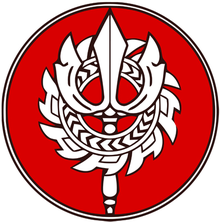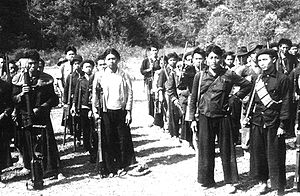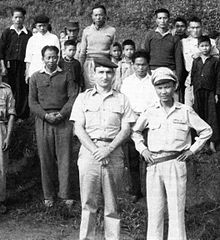Royal Lao Armed Forces
| Royal Lao Armed Forces | |
|---|---|
| Forces Armées du Royaume ກອງທັບຣາຊອານາຈັກລາວ | |
 Royal Lao Armed Forces emblem (1961-1975) | |
| Founded | 1959 |
| Disbanded | 1975 |
| Service branches | Royal Lao Army Royal Lao Air Force Royal Lao Navy |
| Headquarters | Phone Kheng (Vientiane) |
| Leadership | |
| Commander-in-Chief | Soulivong Savang |
| Commander | Phasouk Somly Rasaphak |
| Personnel | |
| Active personnel | 100,000 men (at height) |
| Reserve personnel | 96,000 |
| Industry | |
| Foreign suppliers | |
| Related articles | |
| History | Military history of Laos |
| Ranks | Military ranks of the Royal Lao Armed Forces |
The Royal Lao Armed Forces (Lao: ກອງທັບຣາຊອານາຈັກລາວ; French: Forces Armées du Royaume), best known by its French acronym FAR, were the official armed defense forces of the Kingdom of Laos, a state that existed from 1949 to 1975 in what is now the Lao People's Democratic Republic. First created under the French protectorate of Laos on July 1, 1949, the FAR was responsible for the defense of the Kingdom since its independence in October 1953 from France, until its dissolution on December 2, 1975. It operated notably during the North Vietnamese invasion of Laos and the Laotian Civil War from 1960 to 1975.
History
This section needs expansion. You can help by adding to it. (November 2022) |
The foundations of the Royal Lao Armed Forces were laid on May 11, 1947 when King Sisavang Vong granted a constitution declaring Laos an independent nation (and a Kingdom from 1949) within the colonial framework of French Indochina. This act signalled the creation of a Laotian government capable of building its own administration over the next few years, including the establishment of a national defense force. The new Laotian military was officially created on July 1, 1949 from a collection of pre-existing Lao police and militarized constabulary units, regular colonial indigenous troops, and locally raised irregular auxiliaries. However, the formation process was soon hampered by the developments of the ongoing First Indochina War in neighbouring Vietnam, and it was only in 1952 that the National Laotian Army (Armée Nationale Laotiènne or ANL) – the predecessor of the Royal Lao Army[1] – really began to take shape.
By July 1959, it was known as the Laotian Armed Forces (Forces Armées Laotiènnes – FAL), and in September 1961, was renamed Royal Armed Forces (Forces Armées du Royaume – FAR).[2]
Command structure
Throughout its existence, the Laotian Armed Forces were plagued by an ineffective leadership, particularly at senior levels, which often led to chain-of-command problems. The earlier colonial ANL units in the
), rather than learning their trade. As a result, the FAR officer corps was riven by corruption and inefficiency, exacerbated by political divisions and even personal rivalries at all echelons of command. Both professional and personal jealousy was not unknown amongst Laotian higher Commanders, which resulted in endless internal squabbles, and little effort was made to coordinate their activities, rendering the Command, control and coordination of military operations problematic.This situation was further complicated by a decentralised command structure, in which the FAR
Regional commands
Laos was divided since 1955 into five Military Regions (Régions Militaires) roughly corresponding to the areas of the country's 13 provinces.[10] The Military Regions were the basis of the warlordism culture that affected the ANL and the FAR high command, with most of the MR Commanders running their zones like private fiefdoms.[11]
Branches
By September 1961 the Royal Lao Armed Forces consisted of three conventional ground, air and naval branches of service. Their primarily roles were: guarantee the sovereignty of the King, ensure internal stability and security by maintaining the social and political order, and defend the Kingdom of Laos against external aggression. Subordinated to the Ministry of Defense of the Royal Lao Government at the capital Vientiane, the FAR branches were organized as follows:
- Royal Lao Army (Armée Royale du Laos – ARL)
- Royal Lao Air Force (Aviation Royale Laotiènne – AVRL)
- Royal Lao Navy (Marine Royale Laotiènne – MRL)
Elite formations

- Royal Lao Army Airborne
- Military Region 5 Commandos
- Commando Raider Teams
- SPECOM
- Special Guerrilla Units (SGU)
- Directorate of National Coordination
Training institutions
Prior to its independence in October 1953, Laos lacked almost completely a professional military school system – Officer, Non-commissioned officer (NCO) and Staff schools, plus Technical and Branch training schools – for its Armed Forces, and relied heavily on foreign assistance to train its personnel. Beginning in the early 1950s, Laotian Officers and selected enlisted men were sent overseas to attend specialized courses and advanced schools, and this practice would continue throughout the 1960s and early 1970s. However, a small indigenous training infrastructure (initially run exclusively by the French) gradually began to take shape during the last years of the First Indochina War, and as the Laotian Civil War progressed, it was expanded with the help of the American aid programs, with most of the training being carried out by U.S. advisors.
Lao Military Academy and Staff College
The first Laotian military schools were established by the French Union Army Command in 1952, with the creation at
Laotian Armed Forces training Centres
Six Laotian Armed Forces training Centres (Centres de Formation des Forces Armées Laotiénnes – CFFAR) were established jointly by the French and U.S. Operation Hotfoot mobile training team advisors at Khang Khay in Military Region 2 (MR 2), at Kilometre 17 (KM 17) and Kilometre 22 (KM 22) both located northeast of Vientiane on Route 13, and at Luang Prabang, Savannakhet and Pakse between July 1959 and March 1960, in order to provide basic infantry and Ranger training to both regular RLA and irregular SGU Laotian troops.[15][16]
Airborne training centres
To train Laotian paratrooper battalions, airborne training centres were established by the French at
Commando and infantry training centres
In the midst of the 1971 reorganization, two dual commando/infantry training centres were set up by the Americans at
Armour training centre
In December 1961, the Neutralists set up an Armoured Training Centre at
Aviation school
A flying school was first established by the French at Wattay Air Base in January 1955 to train Laotian pilot cadets,[23] later transferred to Seno Air Base and placed under the control of the RLAF's Air Training Command – ATC (Commandement de l'Entraînement Aérienne – CEA).
Foreign assistance

Throughout its existence, the Laotian Armed Forces received military assistance at different periods and lengths of time from several countries, including France, the United Kingdom, the United States, Thailand, Burma, the Philippines, the Republic of China (Taiwan), South Vietnam, Indonesia, Australia, and (briefly) from North Vietnam and the Soviet Union.[24]
To meet the threat represented by the
Laotian student candidate officers (Aspirants) and senior officers were first sent to France, and later Thailand and the United States, to receive basic officer and advanced staff training in their respective Military Academies and Staff Colleges. At least ten Laotian Aspirants were sent to the prestigious
Paratrooper and 'Commando' units were sent overseas to receive advanced airborne and reconnaissance training, with Laotian pupils attending the
In late 1955, 22 Royal Laotian Air Force cadets attended flight courses at the
See also
- 1967 Opium War
- Air America
- Battle of Lang Vei
- Forces Armées Neutralistes
- Laotian Civil War
- Lao People's Armed Forces
- Project 404
- Pathet Lao
- Vietnam War
- Khmer National Armed Forces
- Republic of Vietnam Military Forces
- Royal Lao Police
- Weapons of the Laotian Civil War
Notes
- LCCN 95017235. Retrieved 5 February 2022.
- ^ Conboy and Greer, War in Laos 1954–1975 (1994), pp. 5–7; 13.
- ^ Anthony and Sexton, The War in Northern Laos (1993), pp. 11–13.
- ^ Conboy and McCouaig, The War in Laos 1960–75 (1989), p. 12.
- ^ Conboy and Morrison, Shadow War: The CIA's Secret War in Laos (1995), p. 14.
- ^ Fall, Anatomy of a Crisis: The Laotian Crisis of 1960–1961 (1969), p. 17.
- ^ Anthony and Sexton, The War in Northern Laos (1993), p. 5.
- ^ Conboy and Greer, War in Laos 1954–1975 (1994), p. 14.
- ^ Anthony and Sexton, The War in Northern Laos (1993), p. 70, note 47.
- ^ Conboy and McCouaig, The War in Laos 1960–75 (1989), p. 4.
- ^ Conboy and Greer, War in Laos 1954–1975 (1994), p. 14.
- ^ Sananikone, The Royal Lao Army and U.S. Army advice and support (1981), p. 17.
- ^ Sananikone, The Royal Lao Army and U.S. Army advice and support (1981), p. 19.
- ^ Sananikone, The Royal Lao Army and U.S. Army advice and support (1981), p. 18.
- ^ Conboy and Greer, War in Laos 1954–1975 (1994), pp. 7-8.
- ^ Conboy and Morrison, Shadow War: The CIA's Secret War in Laos (1995), pp. 23–24.
- ^ Conboy and McCouaig, The War in Laos 1960–75 (1989), pp. 24; 33.
- ^ Conboy and McCouaig, South-East Asian Special Forces (1991), pp. 15–19.
- ^ Conboy and McCouaig, South-East Asian Special Forces (1991), p. 19.
- ^ Conboy, FANK: A History of the Cambodian Armed Forces, 1970–1975 (2011), pp. 275–276.
- ^ Conboy and McCouaig, The War in Laos 1960–75 (1989), p. 46, Plate G2.
- ^ Grandolini, Armor of the Vietnam War (2): Asian Forces (1998), p. 13.
- ^ Conboy and Greer, War in Laos 1954–1975 (1994), p. 6.
- ^ Conboy and McCouaig, The War in Laos 1960–75 (1989), p. 5.
- ^ Conboy and McCouaig, The War in Laos 1960-75 (1989), pp. 24; 33.
- ^ Ahern, Undercover Armies: CIA and Surrogate Warfare in Laos (2006), pp. 52; 55.
- ^ Castle, At War in the Shadow of Vietnam (1993), pp. 9-12; 15-19.
- ^ Sananikone, The Royal Lao Army and U.S. Army advice and support (1981), pp. 17–18.
- ^ Sananikone, The Royal Lao Army and U.S. Army advice and support (1981), p. 18.
- ^ Conboy and McCouaig, South-East Asian Special Forces (1991), p. 28.
- ^ Conboy and McCouaig, South-East Asian Special Forces (1991), pp. 16–18; 23; 28.
- ^ Conboy and McCouaig, South-East Asian Special Forces (1991), pp. 48–50.
- ^ Grandolini, Armor of the Vietnam War (2): Asian Forces (1998), p. 13.
- ^ Conboy and McCouaig, South-East Asian Special Forces (1991), p. 19.
- ^ Conboy and Morrison, Shadow War: The CIA's Secret War in Laos (1995), p. 27, note 24.
- ^ "Welcome to the Air Combat Information Group". www.acig.org. Retrieved 16 April 2012.
- ^ http://www.utdallas.edu/library/collections/speccoll/Leeker/history/Laos3.pdf, p. 13. Retrieved 21 April 2012.
- ^ Conboy and Greer, War in Laos 1954–1975 (1994), pp. 28-29.
- ^ Conboy and Greer, War in Laos 1954–1975 (1994), p. 37.
References
- Andrea Matles Savada (ed.), Laos: a country study (3rd ed.), Federal Research Division, Library of Congress, Washington, D.C. 1995.
- Albert Grandolini, Armor of the Vietnam War (2): Asian Forces, Concord Publications, Hong Kong 1998. ISBN 978-9623616225
- Arnold Issacs, Gordon Hardy, MacAlister Brown, et al., Pawns of War: Cambodia and Laos, Boston Publishing Company, Boston 1987. ISBN 0-201-11678-2, 9780201116786.
- Alfred William McCoy, Cathleen B. Read, Leonard Palmer Adams, The Politics of Heroin in Southeast Asia, Harper & Row, 1972. ISBN 9971-4-7022-5, 9789971470227.
- Bernard Fall, Anatomy of a Crisis: The Laotian Crisis of 1960–1961, Doubleday & Co., 1969. ASIN B00JKPAJI4
- Christopher Robbins, Air America, Avon, New York 1979. ISBN 0-399-12207-9, 9780399122071.
- Christopher Robbins, The Ravens: Pilots of the Secret War in Laos, Asia Books, Bangkok 2000. ISBN 974-8303-41-1, 9789748303413.
- ISBN 978-0-671-69525-5
- Joseph D. Celeski, Special Air Warfare and the Secret War in Laos: Air Commandos 1964–1975, Air University Press, Maxwell AFB, Alabama 2019. – [2]
- Kenneth Conboy and Don Greer, War in Laos 1954–1975, Squadron/Signal Publications, Inc., Carrollton, Texas 1994. ISBN 0897473159
- Kenneth Conboy and Simon McCouaig, South-East Asian Special Forces, Elite series 33, Osprey Publishing Ltd, London 1991. ISBN 1-85532-106-8
- Kenneth Conboy and Simon McCouaig, The War in Laos 1960–75, Men-at-arms series 217, Osprey Publishing Ltd, London 1989. ISBN 9780850459388
- Kenneth Conboy with James Morrison, Shadow War: The CIA's Secret War in Laos, Boulder CO: Paladin Press, 1995. ISBN 978-1581605358, 1581605358
- Maj. Gen. Oudone Sananikone, The Royal Lao Army and U.S. Army advice and support, Indochina monographs series, United States Army Center of Military History, Washington D.C., 1981. – [3]
- Thomas Ahern, Undercover Armies: CIA and Surrogate Warfare in Laos, Center for the Study of Intelligence, Washington D.C. 2006. Classified control no. C05303949.
- Timothy Castle, At War in the Shadow of Vietnam: United States Military Aid to the Royal Lao Government, 1955–1975, Columbia University Press, 1993. ISBN 978-0-231-07977-8
- Victor B. Anthony and Richard R. Sexton, The War in Northern Laos, Command for Air Force History, 1993. OCLC 232549943
Secondary sources
- Kenneth Conboy, Kenneth Bowra, and Simon McCouaig, The NVA and Viet Cong, Elite 38 series, Osprey Publishing Ltd, Oxford 1992. ISBN 9781855321625
- Kenneth Conboy, FANK: A History of the Cambodian Armed Forces, 1970–1975, Equinox Publishing (Asia) Pte Ltd, Djakarta 2011. ISBN 9789793780863
- Khambang Sibounheuang (edited by Edward Y. Hall), White Dragon Two: A Royal Laotian Commando's Escape from Laos, Spartanburg, SC: Honoribus Press, 2002. ISBN 978-1885354143
